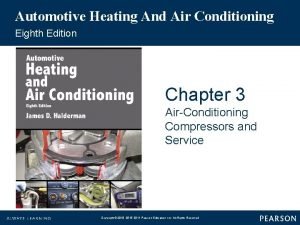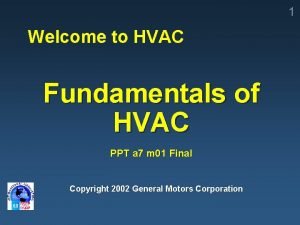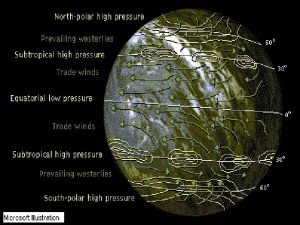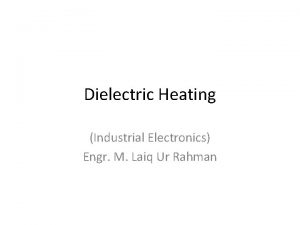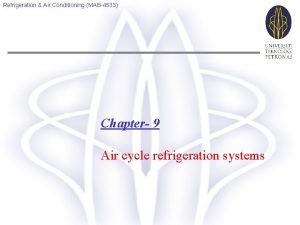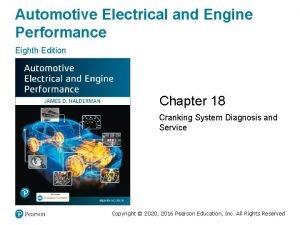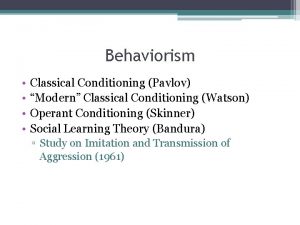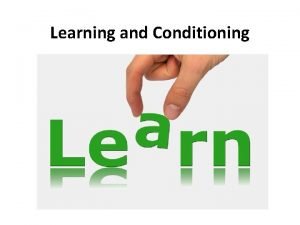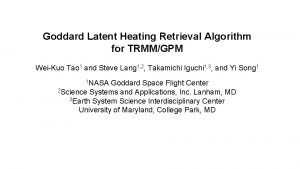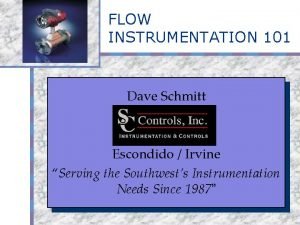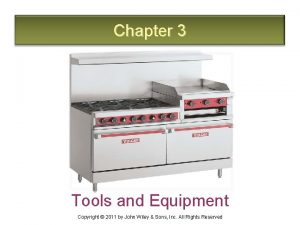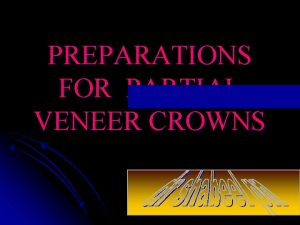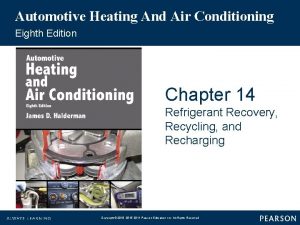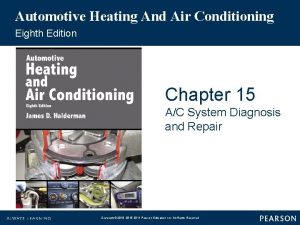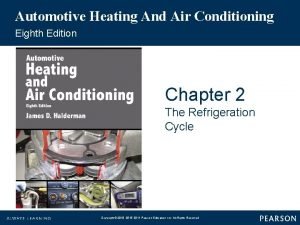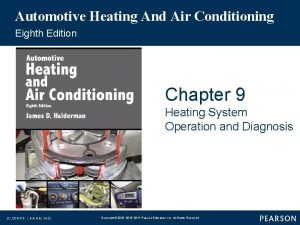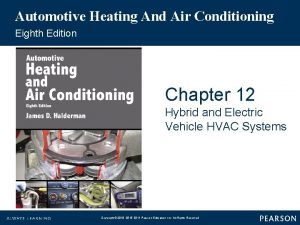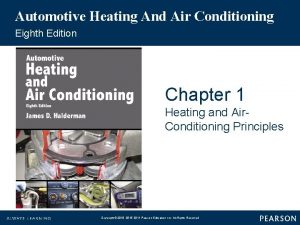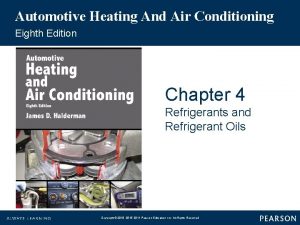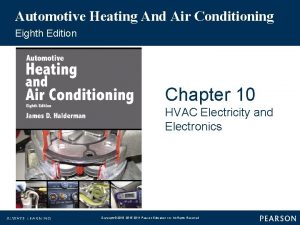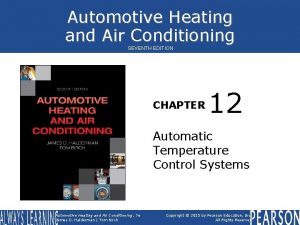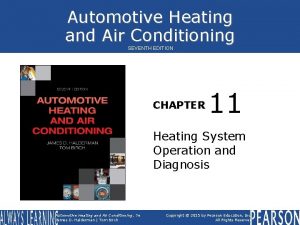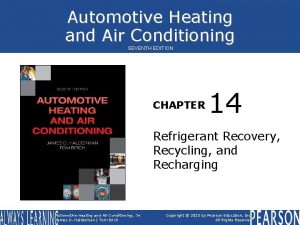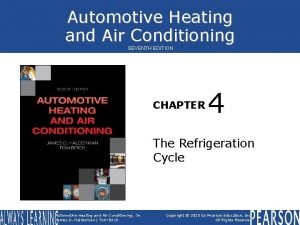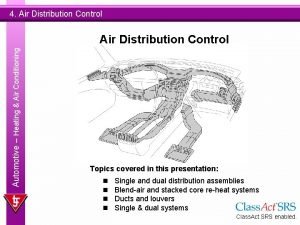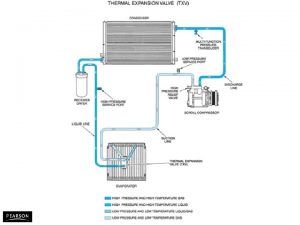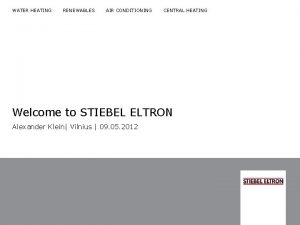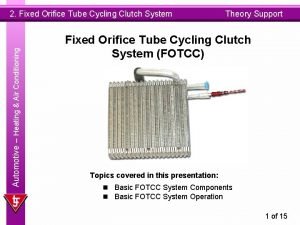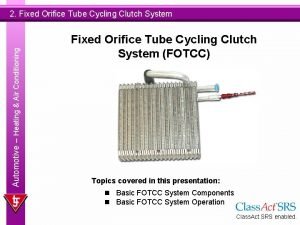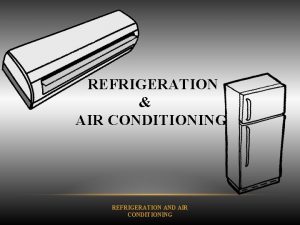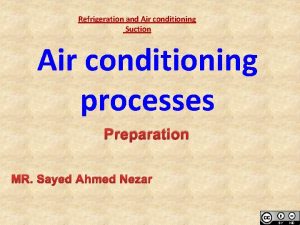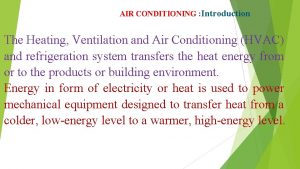Automotive Heating And Air Conditioning Eighth Edition Chapter




































- Slides: 36

Automotive Heating And Air Conditioning Eighth Edition Chapter 6 Air Management System Copyright © 2018, 2015, 2011 Pearson Education, Inc. All Rights Reserved

Learning Objectives (1 of 2) 6. 1 Prepare for the ASE Heating and Air Conditioning (A 7) certification test content area “B” (Refrigeration System Component Diagnosis and Repair). 6. 2 Discuss the different components of an air management system. Copyright © 2018, 2015, 2011 Pearson Education, Inc. All Rights Reserved

Learning Objectives (2 of 2) 6. 3 Explain airflow control and air temperature control in an A/C system. 6. 4 Discuss plenum and control doors. 6. 5 Explain nonelectrical and electronic HVAC controls. Copyright © 2018, 2015, 2011 Pearson Education, Inc. All Rights Reserved

Introduction (1 of 2) • Outside air • Inside air • Air inlet • Temperature-blend door • Mode door Copyright © 2018, 2015, 2011 Pearson Education, Inc. All Rights Reserved

Introduction (2 of 2) • Heat • Air conditioning • Ventilation • Defogging or defrosting the inside of the windshield • HVAC control head Copyright © 2018, 2015, 2011 Pearson Education, Inc. All Rights Reserved

FIGURE 6– 1 The HVAC airflow is directed toward the windshield, dash or floor vents, or combinations depending on the system settings. Copyright © 2018, 2015, 2011 Pearson Education, Inc. All Rights Reserved

Airflow Control • A multispeed blower is used to force air through the ductwork when the vehicle is moving at low speeds or to increase the airflow at any speed • Most systems use a flap door that swings about 45° to 90° Copyright © 2018, 2015, 2011 Pearson Education, Inc. All Rights Reserved

FIGURE 6– 6 Many air control doors swing on their upper and lower pivots, in red. Copyright © 2018, 2015, 2011 Pearson Education, Inc. All Rights Reserved

Air Temperature Control • Most HVAC systems are considered reheat systems in that the incoming air is chilled as it passes through the evaporator. • There is an increasing trend to use an electronically controlled variable displacement compressor with an air temperature sensor after the evaporator. Copyright © 2018, 2015, 2011 Pearson Education, Inc. All Rights Reserved

FIGURE 6– 8 The blower motor forces air to flow through the A/C evaporator to remove moisture from the air before it is sent through the heater core where the air is heated before being directed to the defrost and floor vents. Copyright © 2018, 2015, 2011 Pearson Education, Inc. All Rights Reserved

Air Filtration • HVAC air filter • Interior ventilation filter • Micron filter • Particulate filter • Pollen filter Copyright © 2018, 2015, 2011 Pearson Education, Inc. All Rights Reserved

FIGURE 6– 9 A cabin filter being removed from behind the glove compartment. The dark color is part of the filter and is activated charcoal used to help remove odors. Copyright © 2018, 2015, 2011 Pearson Education, Inc. All Rights Reserved

Cases and Ducts • Plenum – Connected to the air inlets and outlets using formed plastic. These parts are required to contain and direct airflow, reduce noise, keep outside water and debris from entering, and isolate engine fumes and noises Copyright © 2018, 2015, 2011 Pearson Education, Inc. All Rights Reserved

FIGURE 6– 10 A typical HVAC housing that often has to be removed from the vehicle as an assembly to get access to the heater core and evaporator. Copyright © 2018, 2015, 2011 Pearson Education, Inc. All Rights Reserved

Plenum and Control Doors (1 of 6) • Ducts – Air can enter the duct system from either the plenum chamber in front of the vehicle’s windshield (outside air) or from the recirc (short for recirculation) or return register (inside air). • Air doors – This door is normally positioned so it allows airflow from one source while it shuts off the other Copyright © 2018, 2015, 2011 Pearson Education, Inc. All Rights Reserved

Plenum and Control Doors (2 of 6) • The air inlet control door is also called – Fresh air door – Recirculation door – Outside air door Copyright © 2018, 2015, 2011 Pearson Education, Inc. All Rights Reserved

Plenum and Control Doors (3 of 6) • Temperature-Blend Door is also called – – – Air-mix door Temperature door Blend door Diverter door Bypass door Copyright © 2018, 2015, 2011 Pearson Education, Inc. All Rights Reserved

Plenum and Control Doors (4 of 6) • Air from the plenum can flow into one or two of three outlet paths: – The A/C registers (vents) in the face of the instrument panel – The defroster registers at the base of the windshield – The heater outlets at the floor under the instrument panel. Copyright © 2018, 2015, 2011 Pearson Education, Inc. All Rights Reserved

Plenum and Control Doors (5 of 6) • Mode doors are also called function, floor-defrost, and panel-defrost doors. • Mode/function control sets the doors as follows: – A/C: in-dash registers with outside air inlet – Max A/C: in-dash registers with recirculation – Heat: floor level with outside air inlet Copyright © 2018, 2015, 2011 Pearson Education, Inc. All Rights Reserved

Plenum and Control Doors (6 of 6) • Mode/function control sets the doors as follows: – Max Heat: floor level with recirculation – Bi-level: both in-dash and floor discharge – Defrost: windshield registers Copyright © 2018, 2015, 2011 Pearson Education, Inc. All Rights Reserved

FIGURE 6– 12 (a) The temperature and mode doors swing to direct all of the cool air past the heater core, (b) through the core to become hot, (c) or to blend hot and cool air. Copyright © 2018, 2015, 2011 Pearson Education, Inc. All Rights Reserved

FIGURE 6– 13 (a) In a blend-air system, all of the air is cooled. Then some of it is reheated and blended with the cool air to get the right temperature. (b) In a reheat system, all of the air is cooled and then reheated to the correct temperature. Copyright © 2018, 2015, 2011 Pearson Education, Inc. All Rights Reserved

FIGURE 6– 14 Ducts are placed in the center console or on the floor under the front seats to provide heated and cooled air to the rear seat passengers. Copyright © 2018, 2015, 2011 Pearson Education, Inc. All Rights Reserved

Nonelectrical and Electronic HVAC Controls (1 of 6) • Nonelectrical HVAC Controls – Cable-Operated Systems § Mechanical systems are the least expensive § Tended to bind and could require a good deal of effort to operate – Vacuum-Operated Systems § Many vehicles use vacuum actuators, sometimes called vacuum motors, to operate the air inlet and mode doors Copyright © 2018, 2015, 2011 Pearson Education, Inc. All Rights Reserved

FIGURE 6– 16 Many older vehicles used vacuum actuators to move the HVAC doors. When vacuum actuators operate, they alter the air–fuel mixture in the engine. Because vacuum controls affect engine operation and therefore emissions, recent vehicles use electric control systems. Copyright © 2018, 2015, 2011 Pearson Education, Inc. All Rights Reserved

Nonelectrical and Electronic HVAC Controls (2 of 6) • Electronic HVAC Controls – Most recent vehicles use electrical function switches at the HVAC control head. – These switches operate a group of solenoid valves that control the vacuum flow to the vacuum motors or use an electric actuator (motor) to operate the air distribution and temperature-blend doors Copyright © 2018, 2015, 2011 Pearson Education, Inc. All Rights Reserved

Nonelectrical and Electronic HVAC Controls (3 of 6) • Electronic HVAC Controls – A typical two-wire actuator rotates when electric impulses are sent to the brushes by the HVAC control head – A typical three-wire actuator uses a power, ground, and an input signal wire from the HVAC control module Copyright © 2018, 2015, 2011 Pearson Education, Inc. All Rights Reserved

Nonelectrical and Electronic HVAC Controls (4 of 6) • Electronic HVAC Controls – A five-wire actuator uses two wires to power the motor (power and ground) and three wires for a potentiometer that is used to signal the HVAC control module of the motor’s location Copyright © 2018, 2015, 2011 Pearson Education, Inc. All Rights Reserved

Nonelectrical and Electronic HVAC Controls (5 of 6) • Electronic HVAC Controls – Actuator Calibration Procedures § STEP 1 Clear all diagnostic trouble codes (DTCs) § STEP 2 Turn the ignition switch to the off position § STEP 3 Install the replacement actuator and reconnect all mechanical and electrical connections Copyright © 2018, 2015, 2011 Pearson Education, Inc. All Rights Reserved

Nonelectrical and Electronic HVAC Controls (6 of 6) • Electronic HVAC Controls – Actuator Calibration Procedures § STEP 4 Start the engine and select motor recalibration program on the scan tool under the functions menu § STEP 5 Verify that no diagnostic trouble codes have been set. Copyright © 2018, 2015, 2011 Pearson Education, Inc. All Rights Reserved

FIGURE 6– 18 A two-wire HVAC electronic actuator where the direction of rotation is controlled by the HVAC control head or module, which changes the direction of rotation by changing the polarity of the power and ground connection at the motor. Copyright © 2018, 2015, 2011 Pearson Education, Inc. All Rights Reserved

FIGURE 6– 19 Three-wire actuators include a logic chip inside the motor assembly. The HVAC control module then sends a 0 volt to 5 volt signal to the motor assembly to control the direction of rotation. Copyright © 2018, 2015, 2011 Pearson Education, Inc. All Rights Reserved

FIGURE 6– 20 A typical five-wire HVAC actuator showing the two wires used to power the motor and the three wires used for the motor position potentiometer. Copyright © 2018, 2015, 2011 Pearson Education, Inc. All Rights Reserved

Blower Motor Control • Blower speed control in many of these systems is through a multiposition electrical switch and a group of resistors or electronic controls. Copyright © 2018, 2015, 2011 Pearson Education, Inc. All Rights Reserved

FIGURE 6– 21 (a) A typical blower motor assembly with a squirrel-cage fan attached. The hose to the HVAC case is used to bring clean cabin air, instead of dirty outside air, to cool the motor. (b) Blower motor speed is controlled through an electronic circuit (shown) or through a resistor pack. Copyright © 2018, 2015, 2011 Pearson Education, Inc. All Rights Reserved

Summary • Air flows into the case that contains the evaporator and heater core • The HVAC case contains a blower, A/C evaporator, the heater core, and doors to control the air temperature and flow. • Most HVAC systems include a filter to remove particles and odors from the air. Copyright © 2018, 2015, 2011 Pearson Education, Inc. All Rights Reserved
 Automotive heating and air conditioning 8th edition
Automotive heating and air conditioning 8th edition Hvac training ppt
Hvac training ppt Ray's heating & air conditioning
Ray's heating & air conditioning Dielectric heating
Dielectric heating Psychology eighth edition david g myers
Psychology eighth edition david g myers Psychology eighth edition david g myers
Psychology eighth edition david g myers Operations management eighth edition
Operations management eighth edition Limitations of reversed carnot cycle
Limitations of reversed carnot cycle Associative learning
Associative learning Operant vs classical
Operant vs classical Fixed interval
Fixed interval Classical conditioning v. operant conditioning
Classical conditioning v. operant conditioning Classical and operant conditioning
Classical and operant conditioning Automotive technology sixth edition
Automotive technology sixth edition Automotive technology sixth edition
Automotive technology sixth edition Automotive engines 8th edition
Automotive engines 8th edition Difference between classical and operant conditioning
Difference between classical and operant conditioning Variable schedule of reinforcement
Variable schedule of reinforcement Classical and operant conditioning are forms of
Classical and operant conditioning are forms of Classical conditioning vs operant conditioning
Classical conditioning vs operant conditioning Operant conditioning classical conditioning
Operant conditioning classical conditioning Goddard heating and air
Goddard heating and air Rohasys
Rohasys Butler heating and air
Butler heating and air Instrumentation 101
Instrumentation 101 The fifth, sixth, seventh, and eighth amendments protect *
The fifth, sixth, seventh, and eighth amendments protect * Air higroskopis adalah
Air higroskopis adalah This operates simply by heating air in an enclosed space.
This operates simply by heating air in an enclosed space. Anagram of eighth
Anagram of eighth Matching planet rings
Matching planet rings Quarter inch fraction
Quarter inch fraction Eighth commandment catholic
Eighth commandment catholic The eighth wonder
The eighth wonder Three quarter crown preparation
Three quarter crown preparation Eighth amendment excessive bail
Eighth amendment excessive bail Eighth letter of the alphabet
Eighth letter of the alphabet Criminal justice lesson
Criminal justice lesson
